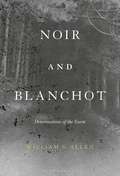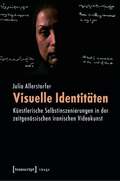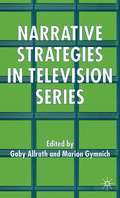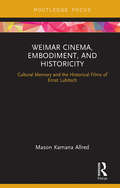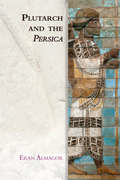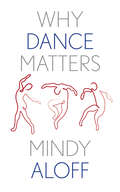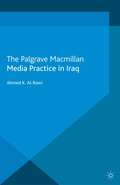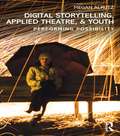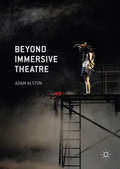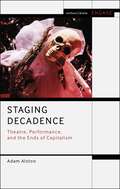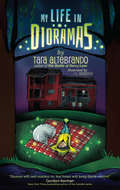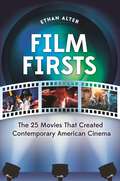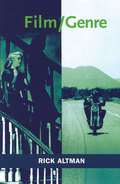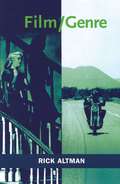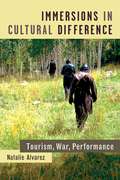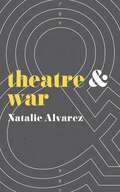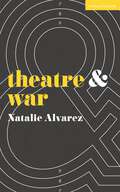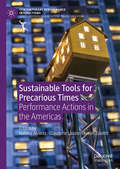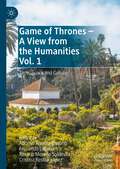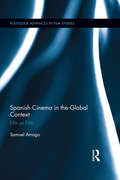- Table View
- List View
Noir and Blanchot: Deteriorations of the Event
by William S. AllenIn dark or desperate times, the artwork is placed in a difficult position. Optimism seems naïve, while pessimism is no better. During some of the most demanding years of the 20th century two distinctive bodies of work sought to respond to this problem: the writings of Maurice Blanchot and American film noir. Both were seeking not only to respond to the times but also to critically reflect them, but both were often criticised for their own darkness. Understanding how this darkness became the means of responding to the darkness of the times is the focus of Noir and Blanchot, which examines key films from the period (including Double Indemnity and Vertigo) alongside Blanchot's writings (particularly his 1948 narrative Death Sentence). What emerges from this investigation is the complex manner in which these works disrupt the experience of time and the event and in doing so expose an entirely different mode of material expression.
Visuelle Identitäten: Künstlerische Selbstinszenierungen in der zeitgenössischen iranischen Videokunst (Image #95)
by Julia AllerstorferKünstlerische Selbstinszenierungen in der zeitgenössischen iranischen Videokunst sind nicht zuletzt durch Identitätskonstruktionen im sowohl inner- als auch außeriranischen visuellen Diskurs geprägt. Im Zentrum dieses Buches stehen Arbeiten von Simin Keramati und Shahram Entekhabi, die in eine breit angelegte kunst- und kulturwissenschaftliche Analyse des Identitätsbegriffs in Iran des 20. und 21. Jahrhunderts eingebettet sind. Julia Allerstorfers interdisziplinäre Studie berücksichtigt aktuelle Debatten um kulturelle Identität in migrativen und länderübergreifenden Kontexten und führt differenziert in performative und de/konstruktive Praxen der Selbstdarstellung in der iranischen Gegenwartskunst ein.
Narrative Strategies in Television Series
by G. Allrath M. GymnichIn the context of a systematic overview of the possibilities of applying narratological concepts to a study of TV series, ten case studies are explored in depth, demonstrating how series such as 24, Buffy, Twin Peaks, Star Trek, Blackadder, and Sex and the City make use of innovative audiovisual means of storytelling. Transgressing the traditional confines of narrative theory, the chapter authors address the question of how form, content, and function intersect in these series.
Weimar Cinema, Embodiment, and Historicity: Cultural Memory and the Historical Films of Ernst Lubitsch (Routledge Focus on Film Studies)
by Mason Kamana AllredIn its retrieval and (re)construction, the past has become interwoven with the images and structure of cinema. Not only have mass media—especially film and television—shaped the content of memories and histories, but they have also shaped their very form. Combining historicization with close readings of German director Ernst Lubitsch's historical films, this book focuses on an early turning point in this development, exploring how the medium of film shaped modern historical experience and understanding—how it moved embodied audiences through moving images.
Weimar Cinema, Embodiment, and Historicity: Cultural Memory and the Historical Films of Ernst Lubitsch (Routledge Focus on Film Studies)
by Mason Kamana AllredIn its retrieval and (re)construction, the past has become interwoven with the images and structure of cinema. Not only have mass media—especially film and television—shaped the content of memories and histories, but they have also shaped their very form. Combining historicization with close readings of German director Ernst Lubitsch's historical films, this book focuses on an early turning point in this development, exploring how the medium of film shaped modern historical experience and understanding—how it moved embodied audiences through moving images.
Plutarch and the Persica
by Eran AlmagorExamines how Cold War films depicted pertinent issues of American social class and gender
Plutarch and the Persica (Edinburgh Studies In Ancient Persia Ser.)
by Eran AlmagorExplores the experiences spectators have when they watch a film collectively in a cinema
Why Dance Matters (Why X Matters Series)
by Mindy AloffA passionate and moving tribute to the captivating power of dance, not just as an art form but as a language that transcends barriers Mindy Aloff, a journalist, an essayist, and a dance critic, analyzes dance as the ultimate expression of human energy and feeling. From her personal anecdotes, her engaging collection of stories about dance from around the world, or her description of the captivating photograph by Helen Levitt of two children dancing, which she sees as one embodiment of the mystery and joy that dancing can evoke, Aloff’s exploration of the aesthetic, social, and spiritual impacts of dance will prove spellbinding. Aloff takes us on a journey through various forms of dance—rituals, religious observances, storytelling, musical interpretations—to show why dance matters to human beings. Interlaced with personal experiences, this book builds on analysis to reveal the intimate relationship we have with dance—personal, spiritual, soul-searching, medicinal, and entertaining. The ideas speak to both specialist and general readers.
Media Practice in Iraq
by A. Al-RawiA historical survey of the Iraqi media from its beginning up to the present day, focusing on the post-2003 media scene and the political and societal divisions that occurred in Iraq after US-led occupation. Investigates the nature of the media outlets and offers an analysis of the way Iraqi satellite channels covered the 2010 general elections.
Digital Storytelling, Applied Theatre, & Youth: Performing Possibility
by Megan AlrutzDigital Storytelling, Applied Theatre, & Youth argues that theatre artists must re-imagine how and why they facilitate performance practices with young people. Rapid globalization and advances in media and technology continue to change the ways that people engage with and understand the world around them. Drawing on pedagogical, aesthetic, and theoretical threads of applied theatre and media practices, this book presents practitioners, scholars, and educators with innovative approaches to devising and performing digital stories. This book offers the first comprehensive examination of digital storytelling as an applied theatre practice. Alrutz explores how participatory and mediated performance practices can engage the wisdom and experience of youth; build knowledge about self, others and society; and invite dialogue and deliberation with audiences. In doing so, she theorizes digital storytelling as a site of possibility for critical and relational practices, feminist performance pedagogies, and alliance building with young people.
Digital Storytelling, Applied Theatre, & Youth: Performing Possibility
by Megan AlrutzDigital Storytelling, Applied Theatre, & Youth argues that theatre artists must re-imagine how and why they facilitate performance practices with young people. Rapid globalization and advances in media and technology continue to change the ways that people engage with and understand the world around them. Drawing on pedagogical, aesthetic, and theoretical threads of applied theatre and media practices, this book presents practitioners, scholars, and educators with innovative approaches to devising and performing digital stories. This book offers the first comprehensive examination of digital storytelling as an applied theatre practice. Alrutz explores how participatory and mediated performance practices can engage the wisdom and experience of youth; build knowledge about self, others and society; and invite dialogue and deliberation with audiences. In doing so, she theorizes digital storytelling as a site of possibility for critical and relational practices, feminist performance pedagogies, and alliance building with young people.
Beyond Immersive Theatre: Aesthetics, Politics and Productive Participation
by Adam AlstonImmersive theatre currently enjoys ubiquity, popularity and recognition in theatre journalism and scholarship. However, the politics of immersive theatre aesthetics still lacks a substantial critique. Does immersive theatre model a particular kind of politics, or a particular kind of audience? What’s involved in the production and consumption of immersive theatre aesthetics? Is a productive audience always an empowered audience? And do the terms of an audience’s empowerment stand up to political scrutiny? Beyond Immersive Theatre contextualises these questions by tracing the evolution of neoliberal politics and the experience economy over the past four decades. Through detailed critical analyses of work by Ray Lee, Lundahl & Seitl, Punchdrunk, shunt, Theatre Delicatessen and Half Cut, Adam Alston argues that there is a tacit politics to immersive theatre aesthetics – a tacit politics that is illuminated by neoliberalism, and that is ripe to be challenged by the evolution and diversification of immersive theatre.
Staging Decadence: Theatre, Performance, and the Ends of Capitalism (Methuen Drama Engage)
by Adam AlstonHow is decadence being staged today – as a practice, issue, pejorative, and as a site of pleasure? Where might we find it, why might we look for it, and who is decadence for?This book is the first monographic study of decadence in theatre and performance. Adam Alston makes a passionate case for the contemporary relevance of decadence in the thick of a resurgent culture war by focusing on its antithetical relationship to capitalist-led growth, progress, and intensified productivity. He argues that the qualities used to disparage the study and practice of theatre and performance are the very things we should embrace in celebrating their value – namely, their spectacular uselessness, wastefulness, outmodedness, and abundant potential for producing forms of creativity that flow away from the ends and excesses of capitalism. Alston covers an eclectic range of examples by Julia Bardsley (UK), Hasard Le Sin (Finland), jaamil olawale kosoko (USA), Toco Nikaido (Japan), Martin O'Brien (UK), Toshiki Okada (Japan), Marcel·lí Antúnez Roca (Spain), Normandy Sherwood (USA), The Uhuruverse (USA), Nia O. Witherspoon (USA), and Wunderbaum (Netherlands). Expect ruminations on monstrous scenographies, catatonic choreographies, turbo-charged freneticism, visions of the apocalypse – and what might lie in its wake.
Staging Decadence: Theatre, Performance, and the Ends of Capitalism (Methuen Drama Engage)
by Adam AlstonHow is decadence being staged today – as a practice, issue, pejorative, and as a site of pleasure? Where might we find it, why might we look for it, and who is decadence for?This book is the first monographic study of decadence in theatre and performance. Adam Alston makes a passionate case for the contemporary relevance of decadence in the thick of a resurgent culture war by focusing on its antithetical relationship to capitalist-led growth, progress, and intensified productivity. He argues that the qualities used to disparage the study and practice of theatre and performance are the very things we should embrace in celebrating their value – namely, their spectacular uselessness, wastefulness, outmodedness, and abundant potential for producing forms of creativity that flow away from the ends and excesses of capitalism. Alston covers an eclectic range of examples by Julia Bardsley (UK), Hasard Le Sin (Finland), jaamil olawale kosoko (USA), Toco Nikaido (Japan), Martin O'Brien (UK), Toshiki Okada (Japan), Marcel·lí Antúnez Roca (Spain), Normandy Sherwood (USA), The Uhuruverse (USA), Nia O. Witherspoon (USA), and Wunderbaum (Netherlands). Expect ruminations on monstrous scenographies, catatonic choreographies, turbo-charged freneticism, visions of the apocalypse – and what might lie in its wake.
My Life in Dioramas
by Tara AltebrandoKate Marino knows very well that home is where her heart is, and if she had any say in the matter, her heart would stay put in Big Red. The old, rambling farmhouse has withstood the test of time with her family, but now Kate's parents have decided to sell it from under her feet. The preventative solution: sabotage the realtor's tours with the help of best friends and a plan that has maximum stinkage potential. The back-up plan: hang on to at least a little bit of life at Big Red by creating shoebox dioramas of each room. But even with a full-scale assault, will her mission be a success? And if not, what will the diorama of Kate's future look like? With a keen eye for capturing the moments that matter, acclaimed author Tara Altebrando explores the pain-and promise-of letting go.CCSS-aligned curriculum guidecan be found online at http://www.rpcurriculumguides.com/curriculum_guides.html
Film Firsts: The 25 Movies That Created Contemporary American Cinema
by Ethan AlterThis forward-looking exploration of contemporary American film across the last 40 years identifies and examines the specific movies that changed the film industry and shaped its present and future.Since the mid-1970s, American cinema has gone through enormous changes, such as the birth of the modern summer blockbuster, the rise of the independent film industry, ongoing technological advancements in special effects, and the ever-evolving models for film distribution. Written by a professional film critic and film buff, this book tells the story of contemporary American cinema in a unique and engaging way: by examining 25 key movies that demonstrated a significant creative, technological, or business innovation that impacted the industry at large.Each chapter in this chronological survey of contemporary film is divided into two sections: "The Film," which offers a critical overview of the film in question; and "The First," which describes the specific innovation achieved by that film and places that achievement in the larger historical context. Two additional appendices in each chapter explore other significant aspects of both the film and its groundbreaking nature. The broad coverage—ranging from action movies to horror films to science fiction favorites—ensures the work's appeal to all film fans.
Film Firsts: The 25 Movies That Created Contemporary American Cinema
by Ethan AlterThis forward-looking exploration of contemporary American film across the last 40 years identifies and examines the specific movies that changed the film industry and shaped its present and future.Since the mid-1970s, American cinema has gone through enormous changes, such as the birth of the modern summer blockbuster, the rise of the independent film industry, ongoing technological advancements in special effects, and the ever-evolving models for film distribution. Written by a professional film critic and film buff, this book tells the story of contemporary American cinema in a unique and engaging way: by examining 25 key movies that demonstrated a significant creative, technological, or business innovation that impacted the industry at large.Each chapter in this chronological survey of contemporary film is divided into two sections: "The Film," which offers a critical overview of the film in question; and "The First," which describes the specific innovation achieved by that film and places that achievement in the larger historical context. Two additional appendices in each chapter explore other significant aspects of both the film and its groundbreaking nature. The broad coverage—ranging from action movies to horror films to science fiction favorites—ensures the work's appeal to all film fans.
Film/Genre (Distributed For The British Film Institute Ser.)
by Rick AltmanFilm/Genre revises our notions of film genre and connects the roles played by industry critics and audiences in making and re-making genre. Altman reveals the conflicting stakes for which the genre game has been played and recognises that the term 'genre' has different meanings for different groups, basing his new genre theory on the uneasy competitive yet complimentary relationship among genre users and discussing a huge range of films from The Great Train Robbery to Star Wars and from The Jazz Singer to The Player.
Film/Genre
by Rick AltmanFilm/Genre revises our notions of film genre and connects the roles played by industry critics and audiences in making and re-making genre. Altman reveals the conflicting stakes for which the genre game has been played and recognises that the term 'genre' has different meanings for different groups, basing his new genre theory on the uneasy competitive yet complimentary relationship among genre users and discussing a huge range of films from The Great Train Robbery to Star Wars and from The Jazz Singer to The Player.
Immersions in Cultural Difference: Tourism, War, Performance (Theater: Theory/Text/Performance)
by Natalie AlvarezIn a time of intensifying xenophobia and anti-immigration measures, this book examines the impulse to acquire a deeper understanding of cultural others. Immersions in Cultural Difference takes readers into the heart of immersive simulations, including a simulated terrorist training camp in Utah; mock Afghan villages at military bases in Canada and the UK; a fictional Mexico-US border run in Hidalgo, Mexico; and an immersive tour for settlers at a First Nations reserve in Manitoba, Canada. Natalie Alvarez positions the phenomenon of immersive simulations within intersecting cultural formations: a neoliberal capitalist interest in the so-called “experience economy” that operates alongside histories of colonization and a heightened state of xenophobia produced by War on Terror discourse. The author queries the ethical stakes of these encounters, including her own in relation to the field research she undertakes. As the book moves from site to site, the reader discovers how these immersions function as intercultural rehearsal theaters that serve a diverse set of strategies and pedagogical purposes: they become a “force multiplier” within military strategy, a transgressive form of dark tourism, an activist strategy, and a global, profit-generating practice for a neoliberal capitalist marketplace.
Theatre and War (Theatre And)
by Natalie AlvarezTheatre and war have long been bedfellows. This brief study looks beyond theatre that is about war, and instead focuses on the relationship between theatre and war: how they feed into and inform one another, from rehearsal to post-production analysis. The study builds on the premise that theatre and war share a deep kinship that finds its consummate expression in the very phrase 'theatre of war.' This critical look at the entangled history of theatre and war asks pressing questions that remain pertinent to our current moment: how have the tools of theatre been used in the waging of war? How have the tools of waging war been used in the making of performance? What are the 'shared interests' of theatre and war? And how has performance become a militarized paradigm
Theatre and War (Theatre And)
by Natalie AlvarezTheatre and war have long been bedfellows. This brief study looks beyond theatre that is about war, and instead focuses on the relationship between theatre and war: how they feed into and inform one another, from rehearsal to post-production analysis. The study builds on the premise that theatre and war share a deep kinship that finds its consummate expression in the very phrase 'theatre of war.' This critical look at the entangled history of theatre and war asks pressing questions that remain pertinent to our current moment: how have the tools of theatre been used in the waging of war? How have the tools of waging war been used in the making of performance? What are the 'shared interests' of theatre and war? And how has performance become a militarized paradigm?
Sustainable Tools for Precarious Times: Performance Actions in the Americas (Contemporary Performance InterActions)
by Natalie Alvarez Claudette Lauzon Keren ZaiontzThis book charts the changing frontiers of activism in the Americas. Travelling Canada, the US, the US-Mexico border, Chile, Argentina, Brazil, Cuba, Colombia, and Indigenous territories on Turtle Island, it invites readers to identify networks, clusters, and continuities of art-activist tactics designed to exceed the event horizon of the performance protest. Essays feature Indigenous artists engaging in land-based activism and decolonial cyberactivism, grass-roots movements imagining possible futures through cross-sector alliance building, art-activists forwarding tactics of reinvention, and student groups in the throes of theatrical assembly. Artist pages, interspersed throughout the collection, serve as animated, first-person perspectives of those working on the front lines of interventionist art. Taken together, the contributions offer a vibrant picture of emergent tactics and strategies over the past decade that allow art-activists to sustain the energy and press of political resistance in the face of a whole host of rights emergencies across the Americas.
Game of Thrones - A View from the Humanities Vol. 1: Time, Space and Culture
by Alfonso Álvarez-Ossorio Fernando Lozano Rosario Moreno Soldevila Cristina Rosillo-LópezThis book reflects on time, space and culture in the Game of Thrones universe. It analyses both the novels and the TV series from a multidisciplinary perspective ultimately aimed at highlighting the complexity, eclecticism and diversity that characterises Martin’s world. The book is divided into three thematic sections. The first section focuses on space—both the urban and natural environment—and the interaction between human beings and their surroundings. The second section follows different yet complementary approaches to Game of Thrones from an aesthetic and cultural perspective. The final section addresses the linguistic and translation implications of the Game of Thrones universe, as well as its didactic uses. This book is paired with a second volume that focuses on the characters that populate Martin’s universe, as well as on one of the ways in which they often interact—violence and warfare—from the same multidisciplinary perspective.
Spanish Cinema in the Global Context: Film on Film (Routledge Advances in Film Studies #26)
by Samuel AmagoAcross a broad spectrum of media, markets, and national contexts, self-reflexivity continues to be a favored narrative mode with wide ranging functions. In this book Amago argues that, in addition to making visible industry and production concerns within the film text, reflexive aesthetics have a cartographic function that serves to map the place of a film (geographic and cultural) within the global cinemascape, and thus to bring into sharper relief images of the national. Focusing on films in the contemporary Spanish context that in some way reflect back on themselves and the processes of their own production, that purposefully blur the distinction between reality and fiction, or that draw attention to the various modes of cinematic exhibition and reception, Amago proposes ways in which these movies can be employed to understand Spanish national cinemas today as imbedded within a dynamic global system.
